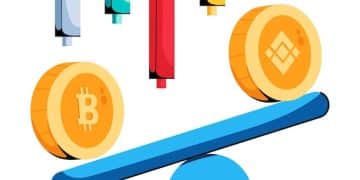Earning Passive Income with Solana DeFi: Staking vs Lending in the US

Earning passive income through Solana DeFi in the US involves staking SOL tokens or lending them on platforms like Solend and Marinade Finance, each offering varying interest rates, risks, and reward mechanisms.
Are you looking to **earning passive income with Solana DeFi: A Comparison of Staking and Lending Platforms in the US**? The Solana ecosystem offers a variety of opportunities to generate yield on your SOL holdings. Two popular methods are staking and lending.
Understanding Solana DeFi
Solana is a high-performance blockchain known for its speed and low transaction costs. This makes it an attractive platform for decentralized finance (DeFi) applications. DeFi on Solana allows users to access financial services like lending, borrowing, and trading without intermediaries. This opens doors for earning passive income in new and innovative ways.
The Solana ecosystem is burgeoning with DeFi protocols, each offering unique features and opportunities. Many of these platforms facilitate staking and lending, providing users with avenues to earn yield on their SOL tokens. But with so many options available, understanding the nuances of each platform is crucial for making informed decisions.
Key Concepts in Solana DeFi
Before diving into specific platforms, let’s cover a few essential concepts. This will provide a solid foundation for understanding how these platforms work and where the opportunities lie.
- Staking: Locking up your SOL tokens to support the Solana network and earn rewards in return. This helps secure the network and validate transactions.
- Lending: Depositing your SOL tokens or other assets into a lending pool, allowing others to borrow them. You earn interest on the borrowed assets.
- Annual Percentage Yield (APY): The total return you can expect to earn on your investment over a year, considering compounding interest.
- Total Value Locked (TVL): The total value of assets deposited in a DeFi protocol. A higher TVL often indicates greater liquidity and stability.
Having a grasp of these concepts sets the stage for a more comprehensive look at the platforms that enable staking and lending within the Solana DeFi space. Knowing the landscape allows you to make better decisions and helps you avoid pitfalls.

Solana Staking Platforms in the US
Staking is one of the most straightforward ways to earn passive income with your SOL tokens. By participating in the Solana network’s validation process, you contribute to its security and earn rewards.
Several platforms facilitate Solana staking in the US, each offering different features and APYs. Let’s explore some of the most popular options.
Marinade Finance
Marinade Finance is a liquid staking protocol that lets you stake your SOL and receive mSOL tokens in return. mSOL represents your staked SOL plus accrued rewards and can be used in other DeFi applications.
Marinade is widely regarded as one of the leading Solana staking platforms. Its liquid staking model offers flexibility and composability.
SolBlaze
This platform offers users the ability to stake SOL and earn bSOL tokens, which can also be utilized across various DeFi protocols for enhanced yield opportunities. The platform is notable for its user-friendly interface and focus on maximizing rewards through innovative staking mechanisms.
SolBlaze distinguishes itself with a blend of security, efficiency, and community-driven development, making it an increasingly popular choice among Solana enthusiasts.
- Benefits of Liquid Staking: Ability to use mSOL or bSOL in other DeFi protocols, maintaining liquidity while earning staking rewards.
- Risks of Staking: Potential impermanent loss if using mSOL or bSOL in liquidity pools.
- APY for Staking: Varies depending on network conditions and platform policies.
These staking platforms provide options for users with different risk tolerances and investment strategies. Liquid staking offers flexibility, while direct staking provides more control over your tokens.
Solana Lending Platforms in the US
Lending your SOL tokens on DeFi platforms offers another avenue for earning passive income. By depositing your tokens into a lending pool, you earn interest as borrowers take out loans.
Several platforms in the US enable SOL lending, each with its own interest rates and risk profiles. Here’s an overview of some leading lending platforms.

Solend
Solend is one of the largest lending protocols on Solana, supporting a wide range of assets, including SOL. It allows users to lend and borrow assets in a permissionless manner.
Solend’s robust infrastructure and extensive asset support make it a popular choice for both lenders and borrowers.
Mango Markets
Mango Markets combines spot margin and perpetual futures trading with lending. This allows users to earn interest on their deposits while also participating in trading activities.
Mango Markets’ integrated approach offers a unique blend of lending and trading opportunities, catering to more active DeFi users.
- Risks of Lending: Smart contract risks and potential for impermanent loss.
- Benefits of Lending: Earn interest on deposited assets and diversify income streams.
- APY for Lending: Varies based on supply and demand, potentially higher than staking.
Choosing a lending platform depends on your risk tolerance and desired yield. Platforms like Solend offer a broader range of assets and borrowing options, while Mango Markets provides a more integrated trading experience.
Comparing Staking and Lending
Both staking and lending provide avenues for earning passive income with your SOL tokens, but they differ in terms of risk, reward, and complexity.
Understanding these differences is crucial for making informed decisions and aligning your DeFi strategy with your financial goals.
Risk Factors
Staking generally carries lower risk compared to lending, primarily due to the absence of counterparty risk. In staking, you’re mainly exposed to the risks associated with the Solana network itself, such as validator slashing. Lending, on the other hand, involves the risk of borrowers defaulting on their loans, as well as smart contract vulnerabilities.
Lending platforms are susceptible to smart contract risks, where a flaw in the code could lead to loss of funds. Additionally, market volatility can impact the value of collateralized assets, potentially triggering liquidations.
Reward Structure
Staking rewards are typically more predictable and consistent, as they’re tied to block validation and network participation. The APY for staking is often stable, providing a reliable source of passive income.
Lending APYs can fluctuate more significantly, depending on market conditions and demand for borrowing. During periods of high demand, lending rates can surge, providing higher returns. However, they can also drop during periods of low demand, reducing your earnings.
Complexity and Accessibility
Staking is generally simpler to understand and execute, making it a more accessible option for beginners. Platforms like Marinade Finance offer user-friendly interfaces, streamlining the staking process.
Lending can be more complex, requiring a deeper understanding of DeFi protocols and risk management. Evaluating the creditworthiness of borrowers and assessing collateralization ratios can be challenging for novice users.
Strategies for Maximizing Passive Income
To maximize your passive income in the Solana DeFi ecosystem, it’s essential to diversify your strategies and stay informed about market trends.
Combining staking and lending with other DeFi activities can amplify your earnings, but it also requires careful planning and execution.
Diversifying Your Portfolio
Spreading your SOL tokens across multiple staking and lending platforms can mitigate risk. By allocating your funds to different protocols, you reduce your exposure to any single platform’s vulnerabilities.
Consider allocating a portion of your portfolio to stablecoin lending for a more conservative approach. Stablecoins provide stability and can offer attractive interest rates on reputable lending platforms.
Staying Informed about Market Trends
Keep up-to-date with the latest developments in the Solana DeFi space. Monitor APYs, TVL, and emerging platforms to identify new opportunities and adjust your strategies accordingly.
Follow industry news, participate in community forums, and engage with DeFi experts to gain insights and stay ahead of the curve. Knowledge is power when it comes to maximizing your passive income in the dynamic world of DeFi.
Automating Your Strategies
Explore tools and platforms that automate your staking and lending activities. These solutions can help you optimize your yields and minimize the time and effort required to manage your portfolio.
Consider using yield aggregators that automatically allocate your funds to the highest-yielding opportunities. These platforms continuously monitor the market and rebalance your portfolio to maximize your returns.
Security Considerations
Security is paramount when participating in DeFi activities. Protecting your funds against hacks, scams, and vulnerabilities should be your top priority.
Implementing robust security measures and following best practices can significantly reduce your risk exposure.
Using Hardware Wallets
Store your SOL tokens on a hardware wallet, such as Ledger or Trezor. Hardware wallets provide an extra layer of security by keeping your private keys offline, making them inaccessible to hackers.
Always verify the authenticity of your hardware wallet and store it in a secure location. Avoid purchasing hardware wallets from unofficial sources, as they may be compromised.
Researching Platforms and Protocols
Thoroughly research any staking or lending platform before depositing your funds. Evaluate the platform’s security measures, audit history, and track record.
Look for platforms that have undergone rigorous security audits by reputable firms. Check for bug bounty programs, which incentivize hackers to identify and report vulnerabilities.
Practicing Good Password Hygiene
Use strong, unique passwords for all your DeFi accounts. Avoid reusing passwords across multiple platforms and enable two-factor authentication (2FA) whenever possible.
Consider using a password manager to securely store and manage your passwords. Be cautious of phishing attempts and never share your private keys or seed phrases with anyone.
| Key Point | Brief Description |
|---|---|
| 💡 Solana DeFi | High-performance blockchain ideal for decentralized finance applications. |
| 🌱 Staking | Locking SOL to support the network and earn rewards, like on Marinade. |
| 🏦 Lending | Depositing SOL for others to borrow, earning interest, like on Solend. |
| 🛡️ Security | Use hardware wallets and research platforms to protect your funds. |
Frequently Asked Questions
▼
Solana DeFi refers to decentralized financial applications built on the Solana blockchain, known for its speed and low costs. This allows for various financial services without traditional intermediaries.
▼
The primary methods include staking SOL to validate transactions and lending SOL or other assets on DeFi platforms to earn interest from borrowers.
▼
Staking risks involve validator slashing and smart contract vulnerabilities. Lending risks include smart contract risks, borrower defaults, and impermanent loss on liquidity pools.
▼
Diversify your portfolio across multiple platforms, stay informed about market trends, and consider automating your strategies with yield aggregators for best results.
▼
Use hardware wallets for secure storage, research platforms thoroughly before depositing, practice good password hygiene, and enable two-factor authentication whenever possible.
Conclusion
Earning passive income with Solana DeFi offers exciting opportunities for US-based users, but requires a clear understanding of staking, lending, platforms like Solend and Marinade Finance, associated risks, and robust security measures. By diversifying your strategies, staying informed, and prioritizing security, you can navigate the Solana DeFi landscape and maximize your earning potential.





